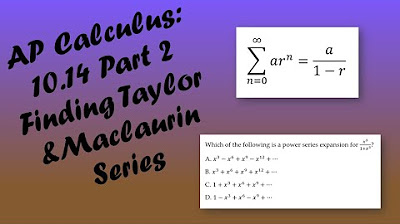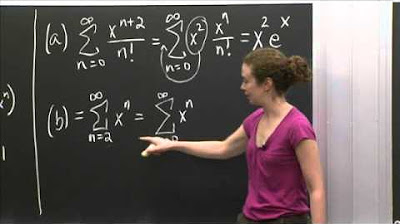Geometric series interval of convergence | Series | AP Calculus BC | Khan Academy
TLDRThe video discusses transforming the function h(x) = 1/(3 + x^2) into a geometric series form. It demonstrates factoring out a 3 and adjusting the series to match the geometric series formula. The common ratio is identified as -x^2/3, and the series is expanded to show its convergence to h(x) within the interval |x| < sqrt(3).
Takeaways
- 🔍 The video discusses transforming a given function into the form of a geometric series.
- 📚 The function h(x) = 1 / (3 + x^2) is used as an example to demonstrate this process.
- 📉 The script emphasizes factoring out a common ratio and expressing the function in the form of a geometric series sum.
- 🌟 The first step involves factoring out 1/3 from the function to simplify the expression.
- 📝 The common ratio for the series is identified as -x^2 / 3, which is crucial for the series representation.
- 🤔 The video encourages viewers to pause and attempt the transformation themselves to enhance understanding.
- 🔢 The script explains how each term in the series is derived by multiplying the previous term by the common ratio.
- 📊 The interval of convergence for the series is determined by the condition that the absolute value of the common ratio must be less than 1.
- 📐 The interval of convergence is calculated to be -√3 < x < √3, ensuring the series converges.
- 📈 The video concludes that within the interval of convergence, the series will converge to the original function h(x).
- 💡 The process illustrates the relationship between power series and geometric series, highlighting the power series as a special case.
Q & A
What is the main topic discussed in the video script?
-The main topic discussed in the video script is the representation of a function as a geometric series and finding its sum, interval of convergence, and common ratio.
What is a geometric series and why is it significant in this context?
-A geometric series is a sequence of numbers where each term after the first is found by multiplying the previous term by a fixed, non-zero number called the common ratio. It is significant in this context because the function h(x) is being represented as a geometric series to find its sum and interval of convergence.
What is the function h(x) given in the script?
-The function h(x) given in the script is h(x) = 1 / (3 + x^2).
How does the script suggest rewriting the function h(x) to represent it as a geometric series?
-The script suggests factoring out a 3 from h(x) and then rewriting it as (1/3) / (1 - (-x^2/3)) to fit the form of a geometric series.
What is the common ratio in the geometric series representation of h(x)?
-The common ratio in the geometric series representation of h(x) is -x^2/3.
What is the first term of the geometric series derived from h(x)?
-The first term of the geometric series derived from h(x) is 1/3.
How does the script describe the process of finding the successive terms in the geometric series?
-The script describes the process of finding the successive terms by multiplying the previous term by the common ratio, -x^2/3.
What is the interval of convergence for the geometric series discussed in the script?
-The interval of convergence for the geometric series is when the absolute value of x is less than the square root of 3, which can be written as -√3 < x < √3.
Why is the absolute value of the common ratio less than 1 important for the convergence of a geometric series?
-The absolute value of the common ratio being less than 1 is important for convergence because it ensures that the terms of the series approach zero, allowing the series to sum to a finite value.
How does the script encourage the viewer to engage with the material?
-The script encourages the viewer to engage with the material by pausing the video at various points to think about the interval of convergence and to try rewriting the function as a geometric series themselves.
What is the significance of the interval of convergence for the function represented as a geometric series?
-The significance of the interval of convergence is that it defines the set of x-values for which the geometric series converges to the original function h(x), ensuring that the series sum is valid and accurate within this range.
Outlines
📚 Converting a Function into a Geometric Series
This paragraph discusses the process of transforming a given function, h(x) = 1 / (3 + x^2), into the form of a geometric series. The speaker begins by suggesting the audience to pause the video and attempt the transformation themselves. The function is factored to isolate the common ratio, which is identified as -x^2 / 3. The series is then represented in the form of a sum from n=0 to infinity, with the first term being 1/3 and the common ratio raised to the power of n. The speaker illustrates how each successive term is derived by multiplying the previous term by the common ratio. The paragraph concludes with the speaker explaining the convergence of the series to the original function h(x) over its interval of convergence.
🔍 Interval of Convergence for a Geometric Series
The second paragraph delves into determining the interval of convergence for the geometric series derived from the function h(x). The interval of convergence is defined as the range of x values for which the absolute value of the common ratio is less than 1. The paragraph guides through the mathematical steps to find this interval, which involves setting the absolute value of x^2 / 3 less than 1 and solving for x. The conclusion is that the absolute value of x must be less than the square root of 3, thus defining the interval of convergence as x being greater than -√3 and less than √3. This interval ensures that the geometric series converges to the original function h(x) within its boundaries.
Mindmap
Keywords
💡Geometric Series
💡Common Ratio
💡Power Series
💡Interval of Convergence
💡Function Representation
💡Factoring
💡Series Expansion
💡Convergence
💡0-th Power
💡Absolute Value
💡Square Root
Highlights
Introduction of converting a function into a geometric series form.
Explanation of the geometric series formula and its conditions.
Demonstration of factoring out a common term to simplify the function.
Transformation of the function into a geometric series by adjusting the denominator.
Identification of the common ratio in the geometric series representation.
Illustration of how to represent the function as a sum of a geometric series.
Calculation of the first term of the series and its significance.
Description of how successive terms in the series are derived.
Explanation of the relationship between the common ratio and the series convergence.
Derivation of the interval of convergence for the geometric series.
Analysis of the conditions for the absolute value of the common ratio to be less than 1.
Calculation of the bounds for x to ensure the series converges.
Conclusion on the interval of convergence for the given power series.
Reiteration of the original function's equivalence to the series within its interval of convergence.
Emphasis on the practical application of geometric series in function representation.
Encouragement for viewers to pause and engage with the material for deeper understanding.
Transcripts
Browse More Related Video

AP Calculus BC Lesson 10.14 Part 2

Finding Derivative Using Limit Definition

2019 AP Calculus AB Free Response Question #6

Power Series Practice | MIT 18.01SC Single Variable Calculus, Fall 2010

Decomposing Functions - Composition of Functions

Derivatives of inverse functions: from table | AP Calculus AB | Khan Academy
5.0 / 5 (0 votes)
Thanks for rating: